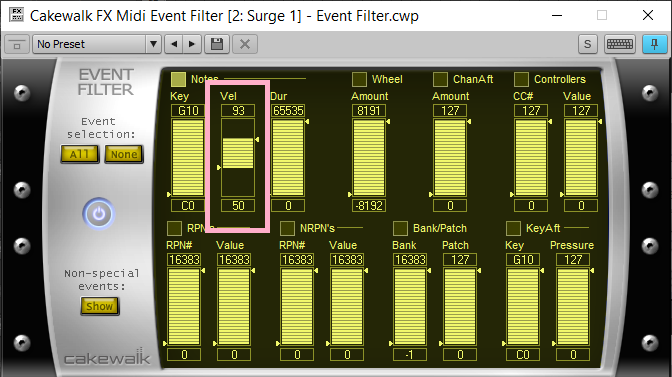-
Posts
6,043 -
Joined
-
Days Won
1
Everything posted by user905133
-

Arm Single Track to Record by Default
user905133 replied to insickness's topic in Cakewalk by BandLab
I'm not sure, but it sounds to me like you want the functionality of a radio button such that pressing record in one place turns off all other record buttons that were on. -
I have a pair of Korg nanoKontrols which have some transport buttons, though I mainly use the sliders, knobs, and non-transport buttons for various parameter controls, usually with Remote Control/MIDI Learn. They are older usb devices. For my purposes and on my PC, I find they work very well with Cakewalk. I have seen discussions of other devices in the forum. Hope this helps. Oh--I also tried TouchDAW and liked it, but I used my tablet for other things and never seemed to have a convenient place for it when doing music.
-
Some questions to try to understand what you proposed: Is the multiplier based on percents? If so, does it have a min and a max--e.g. 0% to 400%? If not, what is it based on (e.g., 127 values)? What hardware/software parameter does it change? Also, can what you want be done with this--the CSMultiCompander? And if so, what settings would give you what you propose if there were a single track control with that functionality? Just trying to understand your proposal. (Apologies if your posts already answer these questions; I have read them and there are issues discussed that prevent me from seeing the answers.)
-
Not sure what you mean here--asking for clarity. With hardware I have frequently used CC 7 for overall volume and CC 11 for per channel volume tweaks. Are you saying that you use a controller that uses expression in a certain way that precludes this usage (or that the use of CC 11 in this way might interfere with someone who might have such a controller)?
-

BandLab will not install Cakewalk, hangs on downloading 0/5
user905133 replied to tommy's question in Q&A
[reply and image of guitarist deleted to reclaim space for future images] -
Its an old one, hasn't been available for a decade (+/-). I just mentioned it as an example. I have seen other samplers listed in the forum that are available. I just don't use them.
-
I use an old sampler--Emulator X. It functions as a standalone sampler and also as a VSTi in Cakewalk. I don't do anything special to make it work as a VSTi. Is the sampler you chose in your VST scan path and did you rescan after you installed it?
-
**Or, if the velocity filter range scale went from 1 to 127 and all notes where vel = 0 were sent along the midi signal path w/o regard to the range setting. I am having a hard time imaging cases/scenarios where I would want to filter out all note offs. You have me wondering if earlier versions of SONAR behaved the same way--that the midi event filter allowed for all note offs [note ons where vel = 0] to be ignored.
-
I am not sure that there is a bug with the MIDI Event Filter itself. It seems to do what it claims to do. Rather it seems to me it is not the solution you want. I think it could be usable for this purpose if there were an option to handle special cases for note events where vel = 0 and those events are being filtered. I am not sure that improvements will be made to MFX by the developers, but maybe it is something @Variorum (or someone else who writes MFX) can do.
-
Hope you don't mind my sharing some additional details about the problem with using the Midi Event Filter as described above. So far as I can tell, the filter acts on midi input the problem is because the note-off [aka note on with a velocity of zero] doesn't get passed on from the filter for any filtered note where min vel > 0
-
Sorry. I used that phrase to refer to "a track with a MIDI FX Event Filter where the velocity range chosen is in the middle a (e.g., 50-93 as pictured) as opposed to being at the low end (e.g., 0 to 80) or the high end (e.g., 50 to 127)." Good to know its only an issue using a controller. I had the same problem as you with a different controller. I suspect it will be a problem with any controller. I have seen other issues with the way Cakewalk handles live midi data. (I gave up trying to get Cakewalk's Inspector-based Arpeggiator to respond properly to remote control midi data.) Glad to see you found a workaround. As for me, I have a software sampler that lets me layer samples. However, using the filter would be quicker for me than re-tooling a multi-sample preset. So, thanks for the solution and for the video.
-
I have set up 3 surge tracks so far and not having the issue yet. I do not have a middle velocity section track yet. If I understand, that is where the problem is right? EDIT: Issue Confirmed. I think we need input from someone with more detailed knowledge than I have; but I will continue to play with this. I have an ancient virtual sampler that allows for velocity switching. I would assume Kontakt has that ability, too, but I rarely use even my free NI instruments. If someone knows how to set velocity ranges in Kontakt, I think that would be better than this MFX work around.
-

Feature Request: Custom Instrument Maps for VSTi's
user905133 replied to JohnK's topic in Feedback Loop
For me, I also like having the old-style tools in the Staff View windows. However, that should be in its own feature request thread. -

Feature Request: Custom Instrument Maps for VSTi's
user905133 replied to JohnK's topic in Feedback Loop
Just to be clear, your basic request is for the ability to create and use Instrument Definitions for soft synths (currently only available for synths accessed via ports and channels) as clarified in the following quote. It makes sense to me if it can be done, esp. for custom patches and patch banks (in addition to factory patches/banks). To clarify: when you referred to ". . . selecting by archaic and meaningless numbers" earlier, I was asking if you were saying the midi port/channel selection process was archaic and meaningless. You have clarified this--it refers to selecting banks and patch numbers devoid of patch names. Thanks. -
Not sure if anything in the colors settings or theme editor would meet your needs; a few weeks ago I played around with some color elements:
-
2021-08-24: This is an old thread. Much has changed. So people don't think my comments from August 10, 2020 are still relevant, I have put them in a light grey font. Also, please see this: =========================================================================================== Not doubting others have had issues; just sharing a few things I noticed on a fresh Cakewalk installation on a new-to-me PC (2012 era computer recently refurbished by a certified reseller with Win 10 Pr v. 2004) in case they help others install Cakewalk. Earlier I had installed the drivers and software for my legacy PCI card. Downloaded Bandlab Assistant from the Cakewalk by Bandlab website. Website warned about using cookies; I said OK. Win 10 Defender red flagged it and ask for my OK; I did. Ran Bandlab Assistant, logged in to my account, chose to install Cakewalk only (no add-ons just yet) Had no downloading meter; just flashing text. Switched to Task Manager to verify the program was doing something (not hanging); it was indeed running. After Cakewalk downloaded, I said OK to run it; watched the progress in the dialog; got the finished message. Ran Cakewalk and stepped through the setup wizard. After testing the PCI card and Cakewalk, the plan is to uninstall Cakewalk, install a few other versions of SONAR so I get my old plug-ins and then re-install Cakewalk. Perhaps that won't go as smoothly. Many tips have been posted previously in different threads. I hope this adds a few more.
-
2021-08-24: This is an old thread. Much has changed. So people don't think my comments from August 10, 2020 are still relevant, I have put them in a light grey font. Also, please see this: =========================================================================================== I suspect that (1) below [killing all Bandlab processes via Task Manager] achieved the same thing as closing it in the system tray. I haven't had an update not work in months, but if I do, I will try the system tray close trick. Thanks for that tip.
-
Makes sense. Thanks for clarifying.
-

Feature Request: Custom Instrument Maps for VSTi's
user905133 replied to JohnK's topic in Feedback Loop
By this are you referring to midi ports and midi channels? -
Did you try opening the *.wrk files up in Cakewalk by Bandlab? I have had no problems with files that predate the Pro Audio series. In fact, being active in the forum during the past year I have seen that the developers have worked on fine tuning compatibility with *.wrk files. You might find that yours work, or maybe there are still some snags. If not, perhaps some more fine-tuning could be done. Doesn't hurt to ask. On the other hand, if you want to pay someone else to do that for you, that's also a valid approach.
-
In another thread, on another matter, I wrote the following: Personally, while I think additional improvements in the download / update installation process are possible and while difficulties and frustrations with all things technological are inevitable, I think (1) you could have made your initial point with less drama and (2) you could be less reactive -- so could some of the people who held up the anger / hostility mirror to you. Just my opinion. You might not be aware that over a span of several months a number of people expressed issues with the need to have their DAW Computer online in order to update Cakewalk. The result was an off-line activation procedure.
-
I wrote the following two days ago, but didn't post it. I'm still not sure.
-
Funny, a few days ago (after my laptop forced v. 2004 on me), I changed some Windows setting and the next thing I knew, my browser had picked up the dark theme--presumably from Windows. For those of you that like dark themes, if Cakewalk dialogs could grab that from Windows, you might like it! Let me see what the forum looks like.



